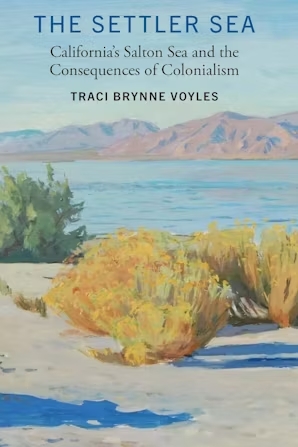In The Settler Sea: California’s Salton Sea and the Consequences of Colonialism, Traci Brynne Voyles, a professor of women’s and gender studies at the University of Oklahoma, catalogs the alarming events that created this environmental disaster as well as the efforts of policy-makers and private interests to maintain a stranglehold on the area they dubbed the Imperial Valley. The story of the Salton Sea is a revealing one, helping us understand the limits of the United States’ ability to conquer and control the landscape.
Voyles pegs the beginning of the desert’s despoliation to the arrival of settlers in the West. Thousands gravitated to the Colorado River in the 1880s and ’90s for the same reason that Indigenous people had done so for thousands of years: Its 1,450-mile run, from the Rocky Mountains to the Gulf of California, provides the most reliable water source in the vast desert that covers North America’s underbelly. Not that the Colorado was ever predictable: In some years the river was a pleasant stream, in others a nightmarish rapid. After engineers repeatedly failed to constrain the river in 1905, a resolute Los Angeles Times declared that “American engineering will not for long be baffled even by a mighty and treacherous Colorado River.” And yet it was: Even in the 1920s, the river troubled many of the region’s residents to such an extent that California Senator Hiram Johnson added “devilish” to the list of pejoratives thrown at the Colorado, in a speech calling for it to be tamed into “a servant of mankind.” If the Southwest was to become a land of plenty for the white settlers who now lived there, the first step was to subdue the Colorado River.
While the Anglos of the Imperial Valley may have been surprised by the Colorado’s wild gyrations, the Cahuilla and Kumeyaay people, who had lived there for centuries, were well acquainted with its tendency to occasionally run so powerfully that it redirected itself away from the Gulf of California and into the Salton Sink.
When that happened, the Cahuillas who lived in the valley would escape to the hills along its edge and, once they had reestablished their settlements, sustain themselves by fishing in the newly formed body of water. After the water evaporated, they dug wells deep into the exposed valley floor and relied on mesquite trees for sustenance. Meanwhile the Kumeyaay, whose traditional lands straddle today’s California-Mexico border, practiced flood irrigation along the Colorado’s banks. As with the Maidu peoples of the Sierra Nevada, who understood forest fires to be a natural part of their homeland’s life cycle, the Cahuilla and Kumeyaay thought of flooding not as something that should be stopped but as a natural process that life had to be oriented around.
